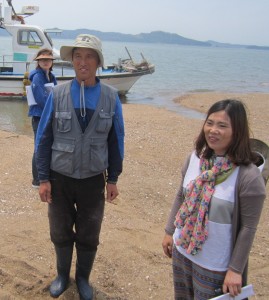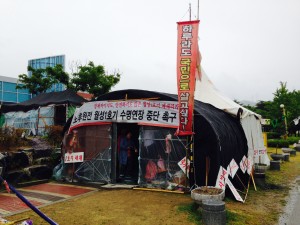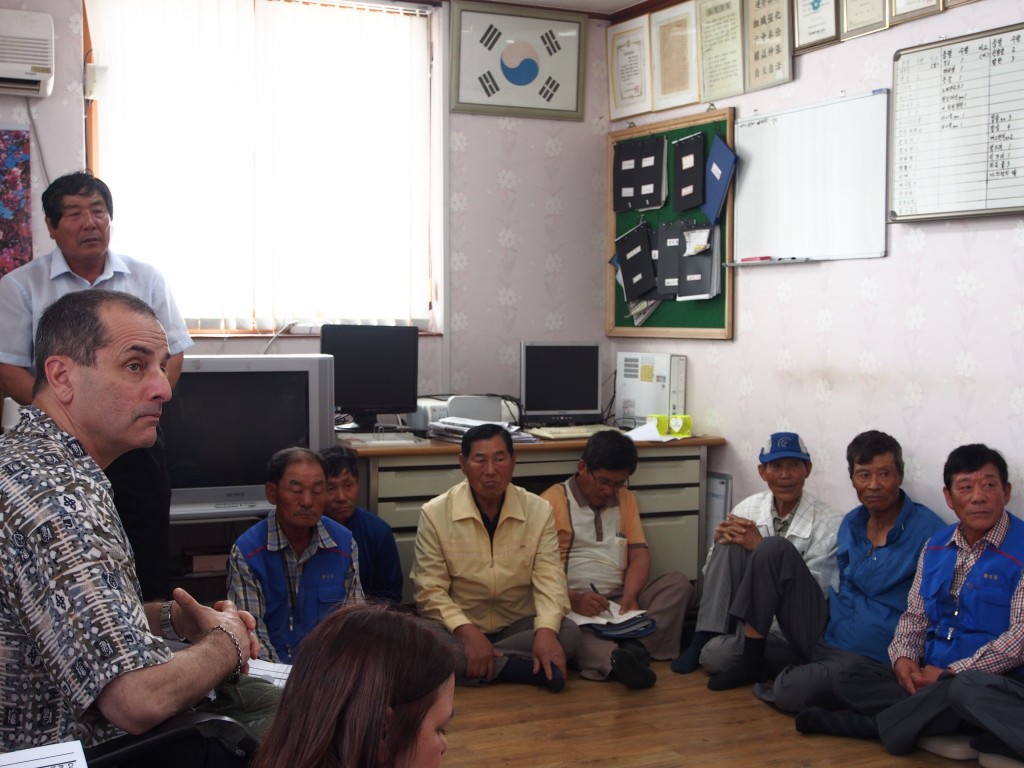Mr. Jeung Sub Park, 58, has been a fisherman and clammer on Garorim Bay on South Korea’s west coast all of his life. For the last six years, he has been leading a fight against so-called “clean energy”. A proposed tidal energy project at the mouth of the bay threatens the rich estuary supporting twenty-one small fishing communities, the fish that spawn there, a robust clam industry, and the endangered spotted seal. Over the years, Mr. Park has taken three solo, week-long marches to petition government officials. In 2008, he camped out in front of the city hall in the provincial capitol for 187 straight days to bring attention to the cause. Earlier this summer, Mr. Park and his supporters “won”. The tidal energy project was shelved, at least until 2020.
As part of a team from Bard College, I recently had the opportunity to visit with grassroots environmental leaders around South Korea, and meet community members battling coal and nuclear pollution, as well as the tidal energy project. Two observations stood out.
In the 1990’s, the Korean government attacked problems of regional urban air and water pollution from the top down, leading to a marked improvement in general environmental quality. Over the last twenty years, democratization in South Korea has opened the door to an emerging environmental justice movement, supporting a second-generation focus on public health and economic vitality in communities negatively impacted by energy development. Depending on the circumstances on the ground, science-based advocacy from the grassroots is engaging national policy-makers with the need to address local community concerns. This growing strength of citizen activism, backed by independent national NGO’s, is charting a new path in East Asia.
Korean activists are also turning their attention to a next frontier: fighting new coal and nuclear plants. A key challenge here is that South Korea has an underdeveloped renewable sector. Despite Korea’s history of nurturing globally competitive industrial and tech sectors, the solar and wind power industries have received little support. With renewables relegated to minor players, Korean environmentalists are focusing on energy efficiency as an alternative, directly tackling the core ideological notion that Korea needs more and more power plants.
Local Campaigns, National Network
Successful environmental campaigns depend on passionate, locally-rooted, charismatic leaders like Mr. Park. They also require sophisticated media and lobbying campaigns supporting front-line communities. The organization fulfilling that role in Korea is often the Korean Federation for Environmental Movement (KFEM).
From a US perspective, KFEM is a mixture of the Sierra Club and the NRDC. With 80,000 members and 50 chapters around the country, the organization has a vibrant and active membership base. It also runs a policy shop in Seoul, pursuing both science-based policy advocacy and legal strategies. Two major differences. First, size: KFEM, by far the largest environmental NGO in Korea has only 20 paid professional staff, compared to more than a thousand working through NRDC and the Sierra Club. Second, funding: There are no foundations or private philanthropists supporting the environmental movement in Korea, so KFEM relies almost exclusively on membership dues for financial support.
Mr. Park’s fight seemed to fit the classic environmentalists versus developers mold. With national support from KFEM, Park and his community deployed familiar protest, media, and lobbying tactics to engage oversight agencies in science-based opposition to the project. The idea for the tidal energy dam was originally proposed in the 1960’s, but had failed to attract sufficient support from the “energy-industrial complex” that drove the country’s massive electrification over the last few decades. The project was revived in 2007 as developers saw an opportunity to gain green credit under a national RPS policy from a low-CO2 tidal energy source. The partnership behind the project included the construction arms of the giant Korean conglomerates (chaebol) Daewoo and Lotte, as well as the national energy company, Kepco.
However, responding to vocal concerns about the impact on the fisheries, threatened species, and community livelihood, the Ministry of the Environment three times rejected the Environmental Impact Assessment submitted by the company. Finally, in the fall of 2014, the environment ministry came out in opposition to the project. Early in 2015, the Ministry of Trade, Industry and Energy announced that further consideration of the project would be delayed for five years.
An hour’s drive north of Garorim Bay, we sat on the floor with a group of twenty men (and a few women listening in from outside the main room) who were fighting a grim front-line battle, and losing. The community was located adjacent to the Dangjin coal-fired power plant. A network of massive high voltage lines hung across the community rice fields. Stepping out of the van to enter the meeting hall we could smell burning coal in the air.
Tension was high in the room, as the men told us how their crops, homes and clothing were blackened by coal soot, their children faced respiratory problems, and their mental health was deteriorating because of fear of exposure to the high voltage power emanating from the lines above their fields. The lines cracked and popped, with enough ambient power, they told us, to light up a fluorescent tube in a farmer’s hand. (On the other side of the coal plant, mountains of coal ash were being used as in-fill behind a tidal dam, adjacent to lush rice fields.) Property values in the community had been reduced to zero, so there was no escape.
The community members were seeking relocation. Government officials were not responsive. The coal plant met Korean air emission requirements, and high voltage exposure is not uncommon for farmers in the rest of Korea, though it is generally not as concentrated. Two opponents of a proposed high voltage line in the center of the country had recently committed suicide out of despair over government inattention to their cause. Similar action may have seemed like the only outlet for some of the community members we spoke with in Dangjin.
The next day, another meeting, this time with community members adjacent to the Ulsan nuclear power plant on the southeast coast. This was a middle- class group, both men and women. We met in a protest tent erected right outside the plant’s public education building, an ultra-modern, pro-nuclear science center with all kinds of cool, interactive displays. Every day, the group marches from their tent in front of the center, down mainstreet with a mock casket, to draw attention to their concerns.
They too are seeking relocation. After Fukishima, the generally pro-nuclear townspeople began to closely examine their situation. Public health studies showed that town residents had levels of radiation in their urine six times higher than communities five kilometers from the plant. Members of the small community had experienced and documented a large number of cancer cases in recent years, and the group feared that the elevated exposure was the cause
Unlike the coal community, the Ulsan residents have unique leverage in their fight for relocation. One of the reactors at the nearby plant had reached the end of its rated life, and had been shut down. The power company had petitioned for a restart, but post-Fukishima politics in Korea had led to the creation of a new national nuclear safety commission. The commission, while including mostly pro-nuclear members, nevertheless provided the three neighboring communities veto power over the Ulsan plant restart, presumably thinking that adequate “compensation” in the form of public amenities would persuade the towns to support the power company. However, while the other two communities had given the green light, enough of the citizens in this community immediately adjacent to the plant were still holding out for relocation. The day we met, the group had received word that a similar relocation push from a community next to a nuclear plant in Pusan, an hour further south, had made some progress.
From our perspective, the struggles of these communities seemed similar to battles here at home, over mountain top removal, toxic exposure from chemical plants, or fracking. As a member-driven organization, KFEM worked to back up the demands emerging from the communities. As in the US, some campaigns win, and some lose, depending on idiosyncractic factors and also, of course, power dynamics. On the one hand, the fisher communities at Garorim Bay have taken on some of the biggest industrial players in Korea and won, at least for now. Yet the marginalized farmers living next to the Dangjin coal plant had no effective voice.
The apparent familiarity of these struggles is a testament to the speed at which Korean democratization has taken root. The independent NGO sector is just two decades old; state repression of activists is a recent memory for many KFEM organizers. In spite of democratization, KFEM faces many more spoken and unspoken constraints on action then do US advocacy organizations. Nevertheless, the emerging model of NGO policy engagement in Korea is rapidly charting a new path for East Asia. In particular, Korea is setting itself apart from Japan, where NGO’s remain largely dependent on the state, and have limited engagement in policy.
Beyond Coal and Nuclear
Beyond seeking protection for impacted communities, the frontier for the Korean environmental movement is effective opposition to new coal or nuclear plants. Activism here is motivated by obvious concerns about a Fukishima-like disaster, accelerating climate change, as well as local impacts of fossil and nuclear development. We spoke with one leader on the southern coast who was fighting a proposed coal plant where thermal pollution from the cooling towers would threaten a very productive fishery. We learned that the Mayor of Seoul had initiated a major highly successful energy efficiency campaign, dubbed the “One Less Nuclear Plant” project. And in the southern city of Gwanju, the policy focus of the municipally-funded Climate and Environment Center was also on energy efficiency.
There appears to be a powerful inertia towards conventional power plant construction in the country— an energy-industrial complex with the political capital and economic might to push through new plants whether they are needed or not. The situation seems reminiscent of US Vice President Cheney’s energy policy plan from the early 2000’s that envisioned over a hundred new coal plants in the US. Yet only a handful of these plants were actually built.
In the US, rising awareness of both climate change risk and economic risk, and realistic assessment of future demand requirements, forced this major and unexpected change in direction. The Sierra Club’s Beyond Coal campaign is credited with stopping a number of proposed plants through local and regional regulatory challenges. At the national level, tightening of mercury standards by the EPA posed a further obstacle to new coal development, and precipitated the shutdown of some older plants. Korean environmentalists can perhaps take heart that what was recently perceived as a fact of life– the political dominance of coal in the US energy mix—is fast fading.
A handicap for Koreans in battles against new coal and nuclear plants is puzzling on its face: the absence of a noticeable renewable energy industry in South Korea. Given the nation’s recent history of effective industrial policy, and its penchant for picking and supporting export “winners” (steel, ship-building, cars, and electronics), one might have supposed that there would be similar push to lead in solar and wind. The lack of Korean strength in these areas is doubly surprising given the emphasis on “green growth” of the recent Lee administration.
One explanation for the weakness of renewables is the countervailing strength of nuclear. Korea relies on nuclear plants for more than 30% of its power, and the principal players in Korea’s energy sector sees export of nuclear technology, especially with Japan sidelined post-Fukushima, as its niche in the global industry field. Possibly as a result, solar and wind have received little industrial policy support in the country. This was also the case in Japan until 2011, but now Japan has one of the most aggressive feed-in tariff policies in the world, and along with China is aggressively pursing solar and wind. Korea’s bet on nuclear against solar is not smart. Even barring another major accident soon, the economics of cheap solar cells will likely soon leave centralized, multi-billion dollar nuclear plants behind, and Korea will be caught playing catch-up.
Nevertheless, without a strong renewable industry yet (and without cheap natural gas) Korean environmentalists are left for now with only one arrow in their quiver. They have to make the effective case that the country simply doesn’t need new nuclear and coal power plants and accompanying transmission lines. Rather, energy efficiency (“One Less Nuclear Plant”) policies can provide needed power more cheaply then new supply: “negawatts” will be cheaper then new megawatts.
Final Observations
The inspiring fight by Mr. Park and his community for Garorim Bay provided a sharp contrast to the desperate situation of coal-town farmers in neighboring Danjin. Yet, the two struggles represent the continuum of an emerging environmental justice movement in which historically marginalized communities are seeking, and sometimes gaining, a voice against a powerful energy-industrial complex. Democratization has provided political space in South Korea for both science-based citizen protest, and national NGO’s that can bring professional resources to bear on local struggles. Changing the nation’s dialog around the need for new nuclear and coal plants is a challenging next frontier.
Post written by Eban Goodstein


